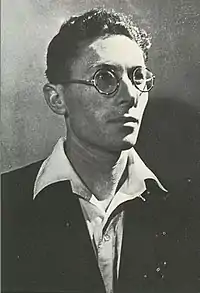Hillel Katz
Hillel Katz (born 24 September 1905 in Cieszyn, Poland) was a Polish Jewish Communist, who was an important member of a Soviet espionage network in occupied France, that the German Abwehr intelligence service later called the "Red Orchestra" ("Rote Kapelle").[1] In the role of an underground executive and recruiter,[2] he acted as both secretary and assistant to Leopold Trepper and liaised between Léon Grossvogel and Henry Robinson in matters relating to the running of the French covert black market trading company Simex.[1] Katz had a number of aliases that he used to disguise his identity, including Andre Dubois, Rene and Le Petite Andre.[1]
Hillel Katz | |
|---|---|
 Hillel Katz | |
| Born | 24 October 1904 |
| Nationality | Polish, Israeli |
| Occupation | Active Resistance member |
| Years active | 1933 to 1943 |
| Organization | Red Orchestra ("Rote Kapelle") |
| Known for | Secretary to Leopold Trepper |
Life

Katz met Trepper in Palestine, where his father was a teacher.[2] In Paris, Katz was one of the two main assistants to Trepper, along with Leon Grossvogel.[3] Katz was totally dedicated, both Trepper and the Communist cause. Trepper described him in a quote as: A mason, he knows how to handle the trowel and build a house.[2]
Katz was particularly interested in educational reform, specifically in the modern and anti-authoritarian approach advocated by Célestin Freinet as well as the works of Maria Montessori.[2] Katz devoted his spare time to the groups of young people that lived in Vitry-sur-Seine, where he organised hiking via the Camping and Culture Association ("Association Camping et Culture").[2]
During the late 1930's, Katz lived at 13 Quai Saint-Michel in Paris, where he was a member of the communist section of the 5th arrondissement of Paris.[4] During that period, Katz worked in a Racine bookshop where he managed the Youth fund.[4] The book shop was popular with militants and political refugees.[4]
In September 1939, Katz enlisted in the French Foreign Legion. He was captured and taken prisoner in June 1940 during the German advance, but managed to escape with Aldred Corbin by swimming across the River Somme.[4] After his escape, Katz started to use the alias André Dubois.[4] Corbin would become a chicken breeder and inventor of poultry feed.[4] Katz would later recruit him for the Trepper group, to store a radio transmitter in Giverny where his poultry farm was located. Corbin would later become the Commerical director of Simex.[4]
Operations
Katz was always cheerful and his direct and frank approach combined with his optimistic demeanour garnered him many friends.[2] These were useful in his work as a recruiter, while he worked at Simex, that enabled him to build relationships using his extensive contacts, to look for people who were Communists or favourably deposed to the group's work.[5] Katz, who knew many of Trepper's contacts and acquaintances, carried out many of Trepper operations personally.[6]
Arrest
On 25 November 1942, Trepper was arrested by Gestapo officer Karl Giering[7] and immediately offered to collaborate with the Abwehr.[8] While Trepper gave up the names and addresses of most of the members of his own network,[9] the first people he betrayed were Katz and Grossvogel.[10]
References
- Kesaris, Paul. L, ed. (1979). The Rote Kapelle: the CIA's history of Soviet intelligence and espionage networks in Western Europe, 1936-1945. Washington DC: University Publications of America. p. 301. ISBN 0-89093-203-4.
- Langeois, Christian (2017). Les chants d'honneur : de la Chorale populaire à l'Orchestre rouge, Suzanne Cointe (1905-1943) (in French). Paris: Cherche midi. p. 135. ISBN 9782749150697. OCLC 1004364617.
- Kesaris, Paul. L, ed. (1979). The Rote Kapelle: the CIA's history of Soviet intelligence and espionage networks in Western Europe, 1936-1945. Washington DC: University Publications of America. p. 87. ISBN 0-89093-203-4.
- Langeois, Christian (2017). Les chants d'honneur : de la Chorale populaire à l'Orchestre rouge, Suzanne Cointe (1905-1943) (in French). Paris: Cherche midi. p. 136. ISBN 9782749150697. OCLC 1004364617.
- Kesaris, Paul. L, ed. (1979). The Rote Kapelle: the CIA's history of Soviet intelligence and espionage networks in Western Europe, 1936-1945. Washington DC: University Publications of America. p. 88. ISBN 0-89093-203-4.
- Diner, Dan (12 January 2017). Enzyklopädie jüdischer Geschichte und Kultur: Band 5: Pr-Sy (in German). Springer-Verlag. p. 265. ISBN 978-3-476-01220-3. Retrieved 15 January 2021.
- Perrault, Gilles (1969). The Red Orchestra. New York: Schocken Books. pp. 254–258. ISBN 0805209522.
- Bauer, Arthur O. "KV 2/2074 - SF 422/General/3". The National Archives, Kew. p. 58. Retrieved 23 July 2020.
- Bauer, Arthur O. "KV 2/2074 - SF 422/General/3". The National Archives, Kew. p. 4. Retrieved 19 January 2021.
- Perrault, Gilles (1969). The Red Orchestra. New York: Schocken Books. pp. 264–268. ISBN 0805209522.